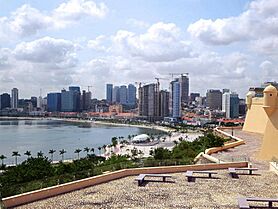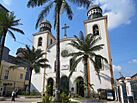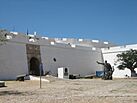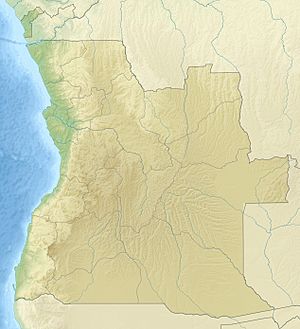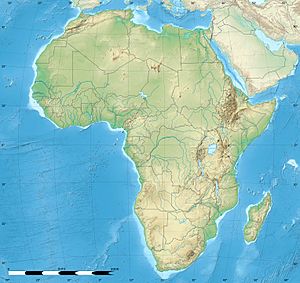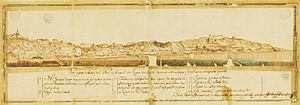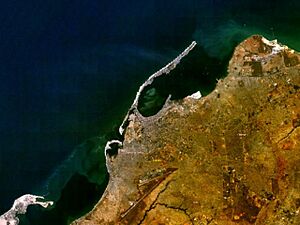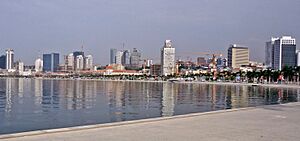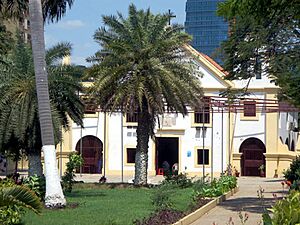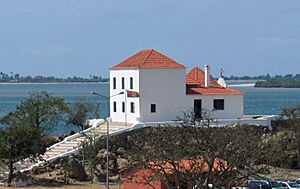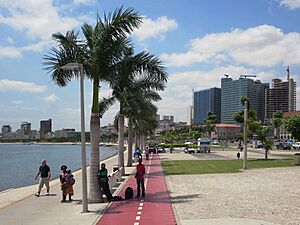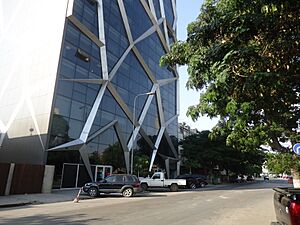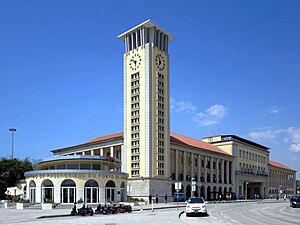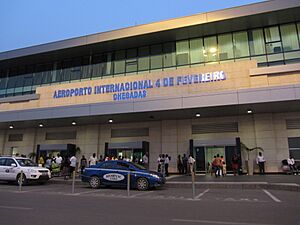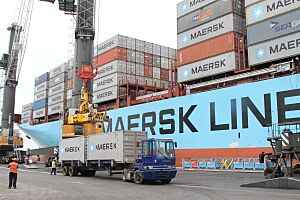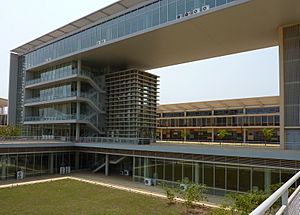Luanda facts for kids
Quick facts for kids
Luanda
|
|
|---|---|
|
Skyline of Luanda
Agostinho Neto Memorial
Church of Our Lady of Remedies
Fortress of São Miguel
Panoramic view of Luanda Bay
|
|
| Country | |
| Province | Luanda |
| Founded | 25 January 1576 |
| Area | |
| • Capital city | 116 km2 (45 sq mi) |
| • Metro | 1,876 km2 (724 sq mi) |
| Elevation | 6 m (20 ft) |
| Population
(2022)
|
|
| • Capital city | 2,831,280 |
| • Density | 24,410/km2 (63,220/sq mi) |
| • Metro | 9,079,811 |
| • Metro density | 4,840.0/km2 (12,536/sq mi) |
| 2022 | |
| Demonym(s) | Luandan; luandense (Portuguese) |
| Time zone | UTC+01:00 (West Africa Time) |
| • Summer (DST) | (Not Observed) |
| HDI (2019) | 0.697 Medium |
Luanda is the capital and largest city of Angola. It is Angola's main port and a big center for industry, culture, and city life. Luanda is located on Angola's northern Atlantic coast. It is also the capital of the Luanda Province. Luanda and its surrounding area are the most populated Portuguese-speaking capital city in the world. It is also the most populated city where people speak Portuguese outside Brazil. In 2020, over 8.3 million people lived there. This is about a third of Angola's total population.
Luanda is one of Africa's oldest colonial cities. A Portuguese explorer named Paulo Dias de Novais founded it on January 25, 1576. It was first called São Paulo da Assunção de Loanda. The city was a major hub for the slave trade to Brazil. This trade stopped later on.
When the Angolan Civil War began in 1975, many Portuguese people left Luanda. The city's population grew a lot because people from other parts of Angola moved there to escape the war. However, the city's services were not ready for so many new people. This led to many musseques (slums) growing around Luanda.
In the 21st century, Luanda has been going through a huge rebuilding process. Many new large buildings are being constructed. These changes are making the city look very different.
Industries in Luanda include making food, drinks, and textiles. They also produce cement, cars, plastics, and cigarettes. The city is also important for its oil industry. There is an oil refinery in Luanda.
Luanda has been named one of the most expensive cities in the world for people from other countries. Most of Luanda's people are from the Ambundu ethnic group. In recent years, more Bakongo and Ovimbundu people have moved there. The Europeans living in Luanda are mostly Portuguese.
Luanda was the main host city for the 2010 Africa Cup of Nations football matches.
Contents
History of Luanda
Early Portuguese Settlement
Portuguese explorer Paulo Dias de Novais founded Luanda on January 25, 1576. He named it "São Paulo da Assumpção de Loanda". He arrived with 100 families and 400 soldiers. Most of the Portuguese lived inside the fort.
In 1618, the Portuguese built the Fortaleza São Pedro da Barra. Later, they built two more forts: Fortaleza de São Miguel (1634) and Forte de São Francisco do Penedo (1765–66). The Fortaleza de São Miguel is the best preserved today.
Luanda was a Portuguese stronghold from 1627. The only time it wasn't Portuguese was during Dutch rule from 1640 to 1648. The city was a center for the slave trade to Brazil from around 1550 to 1836. Most of this trade was done with Brazil. Brazilian ships were the most common in Luanda's port. Local merchants and warriors also made money from this trade. During this time, the Portuguese did not try to conquer large areas. They only set up a few small settlements near Luanda.
In the 17th century, the Imbangala people became the main rivals of the Mbundu in supplying slaves to Luanda. By 1751, between 5,000 and 10,000 slaves were sold each year. At this time, Angola was like a colony of Brazil, which was also a Portuguese colony. Brazil had a strong influence in Luanda until it became independent in 1822.
In the 19th century, Luanda's economy changed a lot under Portuguese rule. The slave trade was stopped in 1836. In 1844, Angola's ports were opened to ships from other countries. By 1850, Luanda was one of the biggest and most developed Portuguese cities outside Continental Portugal. It had many trading companies. They exported palm oil, peanut oil, wax, timber, ivory, cotton, and coffee. Maize, tobacco, and cassava flour were also produced locally. This period saw the rise of a new class of wealthy Angolan business people.
In 1889, Governor Brito Capelo opened an aqueduct. This brought much-needed water to the city. It helped Luanda grow even more.
Growth and Independence

During Portugal's dictatorship, called the Estado Novo, Luanda grew a lot. In 1940, it had 61,208 people, with 14.6% being white. By 1970, it was a rich, diverse city of 475,328 people. About 124,814 (26.3%) were Europeans.
Most of Portuguese Angola, including Luanda, was not affected by the Portuguese Colonial War (1961–1974). The economy grew very fast during this time. In 1982, a report even called Luanda the "Paris of Africa."
When Angola became independent in 1975, Luanda was a modern city. Most of its people were African, but there was also a large group of white Portuguese people.
After the Carnation Revolution in Lisbon in 1974, Angola gained independence. The Angolan Civil War (1975–2002) then began. Most white Portuguese people in Luanda left as refugees. Many went to Portugal, and some traveled to South Africa.
Many skilled technicians came with the Cuban soldiers who supported the MPLA government. They helped restore basic services in the city.
However, in the years that followed, slums called musseques grew very large. They spread far beyond Luanda's old city limits. This happened because of the civil war and many refugees moving from other parts of Angola. For decades, Luanda's services could not keep up with this huge increase in people.
Luanda in the 21st Century
After the civil war ended in 2002, Luanda began a major reconstruction. The economy grew quickly because of oil and diamond production.
Luanda has also become one of the world's most expensive cities. The government sends money to all parts of Angola. However, the capital city gets most of these funds. Since the civil war ended, the country has been stable. Many damaged areas are being rebuilt.
Luanda needed a lot of attention because its population had grown so much. The city's old services, like water, electricity, and roads, were not enough.
Luanda is getting many new roads in the 21st century. New highways are planned to connect it to Cacuaco, Viana, and Samba. New housing is also being built for people living in slums. A large Chinese company is building most of this new housing.
Geography of Luanda
City Layout
Luanda is divided into two main parts. There is the Baixa de Luanda (lower Luanda), which is the old city. Then there is the Cidade Alta (upper city), which is the newer part. The Baixa de Luanda is near the port. It has narrow streets and old colonial buildings. However, new buildings now cover large areas beyond these old parts. Several smaller towns, like Viana, have become part of the city.
Greater Luanda Area
Until 2011, the Luanda Province had five municipalities. In 2011, two more municipalities were added from Bengo Province. These were Icolo e Bengo and Quiçama. The original five municipalities make up Greater Luanda:
| Name | Area in km2 |
Population Census 2014 |
Population Estimate 2019 |
|---|---|---|---|
| Belas | 1,046 | 1,071,046 | 1,271,854 |
| Cacuaco | 312 | 1,077,438 | 1,279,488 |
| Cazenga | 37 | 880,639 | 1,045,722 |
| Luanda (city) | 116 | 2,165,867 | 2,571,861 |
| Viana | 693 | 1,600,594 | 1,900,688 |
| Totals | 2,204 | 6,795,584 | 8,069,613 |
Two new municipalities have been created in Greater Luanda since 2017. These are Talatona and Kilamba-Kiaxi.
City Districts
The city of Luanda has six urban districts. These are Ingombota, Angola Quiluanje, Maianga, Rangel, Samba, and Sambizanga.
More tall buildings are planned for Samba and Sambizanga. Luanda is always growing. It is expanding beyond its official city limits and even into other provinces.
Luanda is home to a Roman Catholic archbishop. It also has most of Angola's schools and universities. These include the private Catholic University of Angola and the public University of Agostinho Neto. The city also has the colonial Governor's Palace. The Estádio da Cidadela (Citadel Stadium) is Angola's main stadium. It can hold 60,000 people.
Luanda's Climate
Luanda has a hot, semi-desert climate. It is warm to hot but surprisingly dry. This is because of the cool Benguela Current offshore. This current stops moisture from easily turning into rain. Even during the dry months from May to October, frequent fog keeps temperatures from dropping at night.
Luanda gets about 405 mm (16 inches) of rain each year. But the amount of rain can change a lot from year to year. Records since 1858 show rainfall from 55 mm (2.2 inches) in 1958 to 851 mm (33.5 inches) in 1916. The short rainy season in March and April depends on a northern current bringing moisture. If the Benguela Current is weak, rainfall can increase by about six times.
Climate Change Impact
A study in 2019 looked at how climate change might affect Luanda. It suggested that by 2050, Luanda's climate could be similar to Guatemala City today. The yearly temperature might go up by 0.7°C (1.3°F).
Another report in 2022 said Luanda is one of 12 major African cities that will be hit hard by future sea level rise. These cities could face billions of dollars in damage by 2050. If sea levels keep rising for thousands of years, the costs will only increase. This is especially true if cities do not take steps to adapt.
People of Luanda
| Year | Population |
|---|---|
| 1970 (Census) | 475,328 |
| 2014 (Census) | 6,760,439 |
| 2018 (Projection) | 7,774,200 |
Most people in Luanda are from African ethnic groups. The main groups are Ambundu, Ovimbundu, and Bakongo. The official language is Portuguese, and it is widely used. However, several Bantu languages are also spoken. These include Kimbundu, Umbundu, and Kikongo.
There is a noticeable number of people of European origin. Many are Portuguese, about 260,000. There are also Brazilians. In recent years, more people from Portugal have moved to Angola. This is because Angola's economy has been growing. There are also immigrants from other African countries. A small group of people from South Africa live there too. Some people in Luanda are of mixed race, with European and African heritage. In the last few decades, a large Chinese community has formed. There is also a smaller Vietnamese community.
Places of Worship
Many places of worship in Luanda are Christian churches. Some of these include:
- Roman Catholic Archdiocese of Luanda (Catholic Church)
- Evangelical Congregational Church in Angola (World Communion of Reformed Churches)
- Evangelical Reformed Church in Angola (World Communion of Reformed Churches)
- Baptist Convention of Angola (Baptist World Alliance)
- Universal Church of the Kingdom of God
- Assemblies of God
- Jehovah’s Witnesses
Culture in Luanda
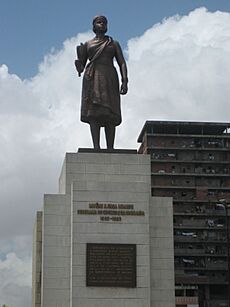
Luanda is the economic and political heart of Angola. It is also the center of Angolan culture. The city has many cultural places, including the Sindika Dokolo Foundation.
The city hosts the yearly Luanda International Jazz Festival, which started in 2009.
Luanda is home to several museums:
- National Museum of Anthropology
- National Museum of Natural History
- Museum of the Armed Forces
- National Museum of Slavery
Other important landmarks in the city include:
- Palácio de Ferro
- Fortress of São Miguel
- Fortress of São Francisco do Penedo
- Luanda Cathedral
- Igreja de Jesus
- Igreja da Nossa Senhora do Cabo
- Igreja da Nossa Senhora da Conceição
- Igreja da Nossa Senhora da Nazaré
- Igreja da Nossa Senhora do Carmo
- Arquivo Histórico Nacional
Luanda's Economy
About one-third of Angolans live in Luanda. More than half of them live in poverty. Living conditions are difficult for most people. Basic services like clean water and electricity are often hard to get. Traffic is also a big problem.
Luanda is known as one of the most expensive cities for foreigners. This is because goods and security are very costly. This high cost has led to a lot of inequality in the city.
New import taxes in March 2014 made Luanda even more expensive. For example, a small tub of ice cream could cost US$31. These taxes were put on many items, from food to cars. The goal was to make Angola's economy less dependent on oil. It aimed to help farming and other industries grow. However, these taxes caused hardship for many. The average salary in Angola was US$260 per month in 2010. But in the oil industry, the average salary was much higher, at US$5,400 per month.
Manufacturing in Luanda includes making processed foods, beverages, and textiles. They also produce cement, building materials, plastic products, and cigarettes. Petroleum from offshore is refined in the city. Luanda has a great natural harbor. Its main exports are coffee, cotton, sugar, diamonds, iron, and salt.
The city also has a strong building industry. This is due to the economic boom since 2002. That's when the civil war ended and political stability returned. Economic growth is mostly supported by oil extraction. But the economy is also becoming more diverse. A lot of money is being invested, both from Angola and other countries. This has greatly increased construction in Luanda. In 2007, the first modern shopping mall in Angola, Belas Shopping, opened in the city.
Transportation in Luanda
Railways
Luanda is the start of the Luanda railway. This railway goes east to Malanje. The civil war damaged the railway. But it has been repaired up to Dondo and Malanje.
Airports
Luanda's main airport is Quatro de Fevereiro Airport. It is the largest airport in Angola. A new international airport, Angola International Airport, is being built southeast of the city. It is near Viana. It was supposed to open in 2011. But the Angolan government stopped making payments to the Chinese company building it. So, the work was paused in 2010. The airport finally opened in November 2023.
Ports
The Port of Luanda is Angola's largest port. It is one of the busiest ports in Africa. This port is also undergoing major expansion. In 2014, a new port began development at Dande, about 30 km (19 miles) north.
Roads
Luanda's roads were in poor condition. But the government is now rebuilding them. This is to help with traffic jams in the city. Major road repairs are happening in almost every neighborhood. This includes a big 6-lane highway connecting Luanda to Viana.
Public Transport
Public transport includes suburban train services from the Luanda Railway. There is also a public company called TCUL. A large number of privately owned shared taxis, called Candongueiro, also provide transport. Candongueiros are usually white-blue minibuses. They are made to carry 12 people, but often carry at least 15. They usually charge 100 to 200 kwanzas per trip. They are known for not always following traffic rules.
In 2019, plans for the Luanda Light Rail network were announced. It is estimated to cost US$3 billion. Construction was expected to start in 2020.
Education in Luanda
International schools in Luanda include:
- Escola Portuguesa de Luanda
- Colégio Português de Luanda
- Colégio São Francisco de Assis
- Luanda International School
- English School Community of Luanda
Universities and Higher Education
Luanda has several universities:
- Agostinho Neto University
- Lusíada University
- Catholic University of Angola
- Technical University of Angola
- Methodist University of Angola
- Private University of Angola
- Jean Piaget University of Angola
- University of Luanda
- Universidade Indepedente de Angola
- Higher Institute of Education Sciences of the Luanda
Sports in Luanda
Luanda's Pavilhão Multiusos do Kilamba has hosted games for Angola's national basketball team many times.
In 2013, Luanda and Namibe (now Moçâmedes) hosted the 2013 FIRS Men's Roller Hockey World Cup. This was the first time a roller hockey World Cup was held in Africa. The city is also home to the Desportivo do Bengo football club.
Luanda's International Connections
Luanda is connected with many cities around the world. These are called twin towns or sister cities.
Twin Towns – Sister Cities
Luanda is twinned with:
 Houston, United States
Houston, United States São Paulo, Brazil
São Paulo, Brazil Lisbon, Portugal
Lisbon, Portugal Oaxaca, Mexico
Oaxaca, Mexico Praia, Cape Verde
Praia, Cape Verde Beira, Mozambique
Beira, Mozambique Windhoek, Namibia
Windhoek, Namibia Bissau, Guinea-Bissau
Bissau, Guinea-Bissau Beijing, China
Beijing, China Macau, Macau
Macau, Macau Maputo, Mozambique
Maputo, Mozambique Tahoua, Niger
Tahoua, Niger São Tomé, São Tomé and Príncipe
São Tomé, São Tomé and Príncipe Johannesburg, South Africa
Johannesburg, South Africa Cairo, Egypt
Cairo, Egypt Porto, Portugal
Porto, Portugal Huambo, Angola
Huambo, Angola Toulon, France
Toulon, France Asunción, Paraguay
Asunción, Paraguay Cape Town, South Africa
Cape Town, South Africa
Images for kids
See also
 In Spanish: Luanda para niños
In Spanish: Luanda para niños


